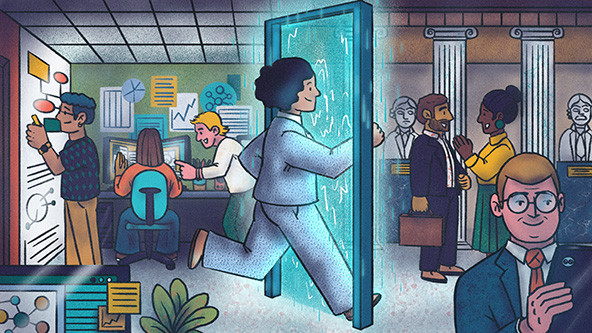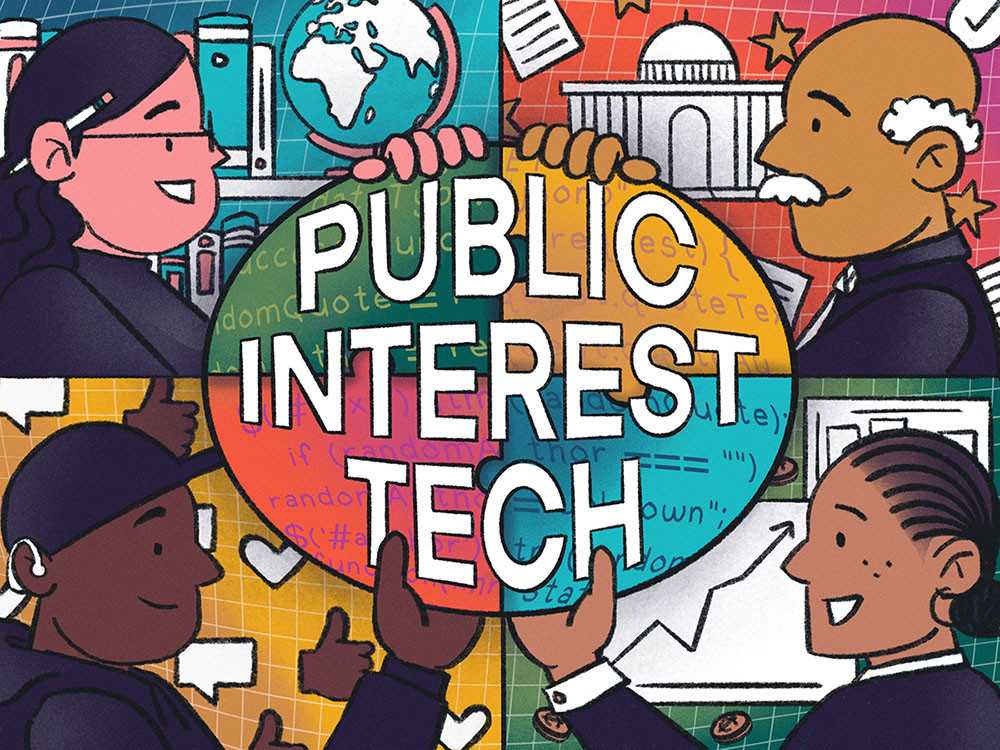 (Illustration by Vreni Stollberger)
(Illustration by Vreni Stollberger)
In the United States, the tech industry and government are often asking themselves the same set of questions: How do we best serve our fellow Americans? How do we make life easier for our people? How do we set an example for the rest of the world? The tech industry produces user and stakeholder research in order to design and build products aimed at improving American lives. The government often does the same—designing and building new laws by consulting constituents and experts. Government is challenged by knowing that even one word in law can positively or negatively impact millions, and the tech industry has grown to know similar levels of impact for their products. The tech industry and government are solving similar problems in different ways, and although profit or politics can get in the way of it, both worlds are called to generate and execute on ideas that will better the lives of the American people.
The similarities between the tech industry and government seem clear to me today, but the intersection of seemingly polar opposite entities was not as obvious when I started my career as a technologist. Since I saw the two as separate, I never thought that an industrial engineering education or a career in software engineering and product management could ever be integrated with government. However, serendipity eventually led me to a career in public interest technology (PIT) working for House Speaker Nancy Pelosi in the chaotic and challenging year of 2020, a move that allowed me to have impact at a scale I never thought possible.

My journey into a career in public interest technology highlights the impact of technical expertise in the public interest space and offers key learnings of ways to help our community grow.
A Shift in Perspective
Before moving to DC, I was a technologist who saw the government as a slow-moving body that was run by an older (sometimes 80+ years old) population who had difficulty grasping the issues plaguing young Americans. Much of my youth in a segregated Chicago was spent believing that the government was there to benefit those with a higher social standing than my family’s, who struggled amongst the lower-middle class. Even the flawed educational system forced my overworked mother to drive my sister and me two hours a day to get an education the inner-city’s elected officials could not always guarantee their youth. I eventually pursued my engineering degree as a way out of these imperfect systems and out of poverty, not necessarily as a way to help others.
But my poor opinion of government shifted in 2019 when a friend of mine, a 30-year-old Black entrepreneur from the South Side, ran for mayor of Chicago. I began to see that the millennial generation had finally reached the age when we could be the policy makers for our cities and for our country—a realization that unknowingly began my career in politics.
While working on the mayoral campaign, I saw the high-level thinking that goes into policymaking in the most politically corrupt city in America. Debating policy ideas about how to improve our struggling city started a fire in me that was never lit during my three years building software products. The policy lens had us asking questions of how to improve K-12 education or how to mitigate police brutality, while the engineering lens brought an entirely new systematic way of solving these problems. The engineering lens also revealed that the future of most policy areas would eventually involve technology.
This feeling of empowerment as a newly minted public interest technologist prompted me to apply to TechCongress, a year-long fellowship that places technologists into a congressional office or committee. I had no idea when I applied that I would end up working for House Speaker Nancy Pelosi in 2020 or that two months after my arrival in Washington, DC, a deadly pandemic would begin.
There was so much that my technical knowledge lent me during that time of crisis. 2020 was the year that COVID-19 and George Floyd protests swept the nation. It was the year that Congress investigated and publicly questioned Big Tech companies while disinformation ran rampant. It was also the year of one of the most polarized elections in our history.
From the vantage point of the speaker’s office, I was able to support every tech policy issue that traveled through the House of Representatives. I worked with fellow public interest technologists in Congress to ask hard questions and examine the potential impact of tech policies on Americans. We discussed what health data should or shouldn’t be collected as COVID-19 apps were being built, we deployed a task force to combat COVID-19 and vaccine misinformation, and pushed for cybersecurity experts in government to respond to surging ransomware attacks. We passed legislation that supplied billions in broadband funds to support our nation as it transitioned to life working and learning from home, catalyzed research into how foreign adversaries influence our elections, and used our experience building apps in the App Store and using Amazon Web Services to report on how big tech companies like Apple and Amazon abuse their monopoly powers.
Successfully working as a technologist in Congress solidified my belief that solving hard problems requires diversity of thought and diversity in expertise. It proved that my obsession with systems thinking and product development mixed with my personal experiences as a Black, queer woman from a lower-income home can actually bring a multitude of unique lenses to government.
Representation, Resources, and Mentorship
Though I was lucky enough to volunteer on a mayoral campaign and serve a year in Congress, these opportunities are not so readily available to others. So then, how do we help more technologists find their place in the public interest space? We can do this by devoting resources, increasing representation, and providing mentorship.
When I first started my career as a technologist, I created a nonprofit for Black women in technology called BlackByte. One goal was to make it easier for Black women at different stages of their tech careers to meet and support one another. I watched women in the community go from having an interest in technology to landing six-figure tech jobs in a matter of a year.
Representation, resources, and mentorship are necessary when any person seeks out a new career or wants to shift positions within an industry. This rings true for technologists entering the public interest space, especially because career paths in public interest technology are less visible than in other industries. Here are a few ideas for supporting technologists at different stages of their careers.
Pre-Career: Technologists at the University Level
- Give representation to students. For the last two years, I have spoken with Purdue University students studying industrial engineering about my experiences working in government. There are a handful of engineering clubs and seminars at universities that bring in mid- to late-career alumni to speak on their experiences as traditional engineers. I personally benefited from the National Society of Black Engineers, the Institute of Industrial and System Engineers, and the Society of Women Engineers, but universities should stand up organizations that allow public interest technologists to represent their work to students. The Public Interest Technology University Network has begun doing much of this work with 48 colleges and universities committed to building the field of public interest technology through the development of curricula, research agendas, and experiential learning programs in the PIT space. These initiatives can show students what a career in public interest technology can look like, such as developing policy, building public interest products, raising tech policy issues through journalism, and more. A small shift in PIT representation leads curious students to learn more about how they can use their tech skills for public service.
- Give students access to resources. Many universities encourage students to get internships in the summer. Engineering programs, for example, offer career fairs that feature traditional engineering companies or require students to work with local engineering companies for their senior projects. Why not stand up programs within universities that allow students to easily do an internship in government? Purdue, for example, has the best agricultural and biological engineering program in the country. Allowing these students to work at the Department of Agriculture for a semester or summer would undoubtedly change it for the better. Many government entities offer internships, but bringing awareness to public interest technology opportunities this early in a technologist's career can forever change the course of their lives and help our country for the better. Already, groups like All Tech is Human are working with universities to design career fairs that intentionally display PIT career opportunities in government and other sectors. And organizations like Coding it Forward offer students internship opportunities on important government work. Investing in more initiatives like these can create a stronger pipeline into the field.
- Create more opportunities for students to meet mentors. Community-building opportunities such as conferences or social convenings will inevitably lead to more mentee/mentor relationships. The Code for America Summit, The Public Interest Technology University Network Annual Conference, and the mentoring process for Coding it Forward summer fellows are positive developments but nowhere near sufficient to meet the needs of this emerging field of leaders.
Early- to Mid-Career
- Create more opportunities and a central location for resources. There are a handful of initiatives gaining momentum for early- to mid-career technologists interested in starting a career in public interest technology. These initiatives include fellowships like TechCongress, Presidential Innovation Fellows, the US Digital Corps, and so many more. Helping these programs scale and working to identify additional gaps where new fellowships would serve the public sector are key, but creating centralized and well-maintained resources on where to find opportunities would be even more useful. We should also be documenting for new technologists how to get started in the field. For example, there is currently no up-to-date map of our federal government and where certain technical skills can be most useful. How would a new technologist know if they wanted to work on tech policy in Congress or join the United States Digital Service or work for the Department of Energy? These types of resources would be helpful for a prospective technologist who is new to public service.
- Help technologists stay in public interest technology. Many PIT recruiting initiatives often fail to create an environment that encourages technologists to stay long term (many go back to the private sector). In my own experience, technologists have left due to a lack of good management (which can be hard to come by in government), a lack of upward mobility due to career paths being unclear, a lack of opportunities to further sharpen their tech skills, and a lack of community. We should invest in educational opportunities for PITs to easily grow into their management and technical skills, and consider funding rotational programs for PITs to learn different ways their technology skills can be useful in government. We must also create community-building opportunities that encourage mid-career peers to network, share new opportunities in the public interest space, and offer access to late-career mentors.
Public interest technologists can tackle a litany of difficult and worthwhile problems, from advising policy makers on how to respond to harmful software features, to creating new research initiatives within a federal agency that will forever change the world (like the internet that you are reading this on), to building better tools for struggling families to access their benefits online. These examples and my own journey are proof that merging unique experiences in public service and technology will create the scale of impact that is necessary to move our ever-advancing technological society forward while consistently answering the question of how to make life better for the American people.
Support SSIR’s coverage of cross-sector solutions to global challenges.
Help us further the reach of innovative ideas. Donate today.
Read more stories by Victoria Houed.

